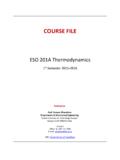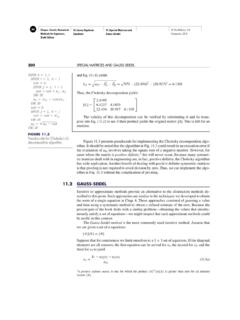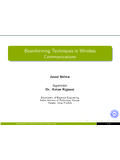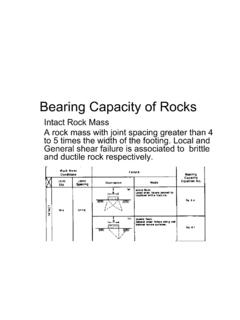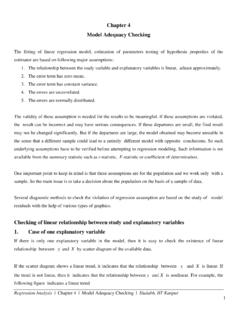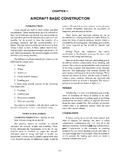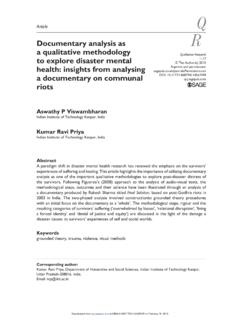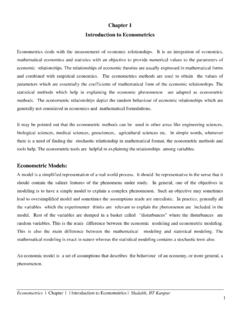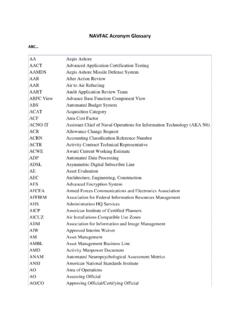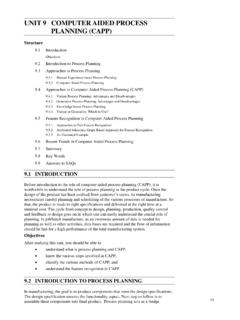Transcription of Computer Aided Manufacturing
1 Computer Aided Manufacturing Prof. Janakarajan Ramkumar Professor Department of Mechanical & design Program IIT Kanpur, India. Contents Manufacturing Use of Computers Computer Applications (CAD, CAM, CAPP etc.). design Process involved Manufacturing Systems and types Introduction to CIM. Sub-systems of CIM. Present Scenario Future Prospects Manufacturing Manufacturing is the process of converting raw materials, components or parts into finished goods that meet a customer's expectations or specifications. Manufacturing is a value-adding process allowing businesses to sell finished products at a premium over the value of the raw materials used. It is a series of interrelated activities and operations involving design , material selection, planning, production, quality assurance, management, and marketing of discrete consumer and durable goods.
2 Manufacturing Use of Computers 1. A Computer is a machine that can be instructed to carry out sequences of arithmetic or logical operations automatically via Computer programming. 2. Modern computers have the ability to follow generalized sets of operations, called programs. 3. These programs enable computers to perform an extremely wide range of tasks. Evaluation of Technology Evaluation of Technology Computer Applications CAD - Computer Aided design . The use of Computer methods to develop the geometric model of the product in three- dimensional form, such that the geometric and Manufacturing requirements can be examined. CADD - Computer Aided design and drafting.
3 Combining the CAD function with drafting to generate the production drawings of the part for the purpose of downstream processing. CAE - Computer Aided engineering. The use of Computer methods to support basic error checking, analysis, optimisation, manufacturability, etc., of a product design . Computer Applications CAM - Computer Aided Manufacturing . Generally refers to the Computer software used to develop the Computer Numerical Control part programs for machining and other processing applications. CAPP - Computer Aided process planning. The use of Computer to generate the process plans for the complete manufacture of products and parts. CATD - Computer Aided tool design .
4 Computer assistance to be used for developing the tools for manufacture such as jigs and fixtures, dies, and moulds. Computer Applications CAP - Computer Aided planning. The use of Computer for many of the planning functions such as material requirement planning, Computer Aided scheduling, etc. CAQ Computer Aided Quality assurance. The use of computers and Computer controlled equipment for assessing the inspection methods and developing the quality control and assurance functions. CAT Computer Aided testing refers to the software tools that can take a system through its various phases of operations and examine the response against the expected results. Computer - Aided technologies 11.
5 design Process design is an activity that needs to be well organised and should take into account all influences that are likely to be responsible for the success of the product under development. design Process Product Engineering Product functions Product Specifications Conceptual design Ergonomics and Aesthetics Standards Detailed design Prototype development Testing Simulation Analysis design Process Manufacturing Engineering Process planning Process sheets Route sheets Tooling Cutting tools Jigs and Fixtures Dies and Moulds Manufacturing Information Generation CNC Part programmes Robot Programmes Inspection (CMM) programmes Stages of design Process Computer assisted design Process Manufacturing Systems Manufacturing systems is a collection of integrated equipment and human resources, whose function is to perform one or more processing and/or assembly operations on a starting raw material, part, or set of parts.
6 It is a logical groupings of equipment and workers in the factory. Components of a Manufacturing System are:- 1. Production machines 2. Material handling system 3. Computer system to coordinate and/or control the preceding components 4. Human workers to operate and manage the system 17. Manufacturing Systems 18. Categories of Manufacturing Systems It is classified in three categories in terms of the human participation in the processes performed by the Manufacturing system: 1. Manual work system - a worker performing one or more tasks without the aid of powered tools, but sometimes using hand tools 2. Worker-machine system - a worker operating powered equipment 3.
7 Automated system - a process performed by a machine without direct participation of a human 19. Categories of Manufacturing Systems (a) Manual work system, (b) worker-machine system, and (c) fully automated system 20. Manufacturing Support Systems Manufacturing support involves a sequence of activities that consists of four functions: 1. Business functions - sales and marketing, order entry, cost accounting, customer billing 2. Product design - research and development, design engineering, prototype shop 3. Manufacturing planning - process planning, production planning, MRP, capacity planning 4. Manufacturing control - shop floor control, inventory control, quality control 21.
8 Manufacturing Support Systems 22. Sequence of Information-Processing Activities in a Manufacturing Firm 23. Automation in Production Systems Automation is technology associated with the applications of Mechanical, electrical and Computer based systems to operate and control production Two categories of automation in the production system: 1. Automation of Manufacturing systems in the factory 2. Computerization of the Manufacturing support systems The two categories overlap because Manufacturing support systems are connected to the factory Manufacturing systems. 24. Automated Manufacturing Systems Examples: Automated machine tools Transfer lines Automated assembly systems Industrial robots that perform processing or assembly operations Automated material handling and storage systems to integrate Manufacturing operations Automatic inspection systems for quality control 25.
9 Automated Manufacturing Systems Car Manufacturing System 26. Introduction to CIM. What is CIM ? 1. Computer -integrated Manufacturing (CIM) is the Manufacturing approach of using computers to control entire production process. This integration allows individual processes to exchange information with each other and initiate actions. 2. Computer -integrated Manufacturing (CIM) makes the use of Computer -controlled machineries and automation systems in Manufacturing products. CIM combines various technologies like CAD and CAM to provide an error-free Manufacturing process that reduces manual labor and automates repetitive tasks. Introduction to CIM. 1. The term " Computer -integrated Manufacturing " is both a method of Manufacturing and the name of a Computer -automated system in which individual engineering, production, marketing, and support functions of a Manufacturing enterprise are organized.
10 2. In a CIM system functional areas such as design , analysis, planning, purchasing, cost accounting, inventory control, and distribution are linked through the Computer with factory floor functions such as materials handling and management, providing direct control and monitoring of all the operations. Computer Assistance Data flow in CIM. Yu et al., Manufacturing letters (2015). CIM Wheel Processes Involved The various processes involved in a CIM are listed as follows: Computer - Aided design Prototype manufacture Determining the efficient method for Manufacturing by calculating the costs and considering the production methods, volume of products, storage and distribution Ordering of the necessary materials needed for the Manufacturing process Computer - Aided Manufacturing of the products with the help of Computer numerical controllers Processes Involved The various processes involved in a CIM are listed as follows: Quality controls at each phase of the development.
